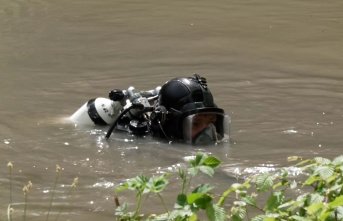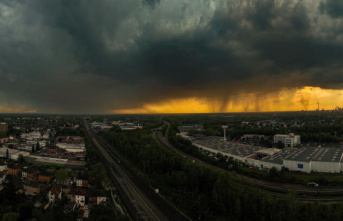For years, the polar bear on the thinning ice floe was the motive for anyone anywhere in the world warning of the consequences of climate change. In the meantime, humanity has fundamentally understood that a changing climate with rising temperatures and more frequent and severe extreme weather events does not only affect the predators in the Arctic. Other images have long served as symbols for the climate crisis, such as those of the destructive floods in the Ahr Valley in 2021 or the equally deadly forest fires in Australia.
The climate crisis has long since been felt where people live. Or as UN Secretary-General António Guterres put it metaphorically when presenting the latest synthesis report from the Intergovernmental Panel on Climate Change (IPCC): "Humanity is on thin ice - and this ice is melting fast."
At the same time, the situation of the white giants has not necessarily improved. Global warming is pushing them to new regions and eating habits, and researchers are seeing alarming signs that chemicals found deep in the ice could be reaching the animals, too. So it's time to ask: how is he, the polar bear?
It depends on your perspective
There is no blanket answer to this question. "It depends a lot on where you look," says leading Norwegian polar bear researcher Jon Aars. "On Spitsbergen, for example, they are still fine. We see many different effects on what they are doing and where they are, but not that their population is declining or that they are unable to breed."
The situation is more difficult elsewhere, says the researcher at the Norwegian Polar Institute. "They're faring much worse elsewhere in the Arctic, and we know that's because of climate change, a warmer climate and less sea ice." The bears are struggling the most in more southern areas of the Arctic, such as Canada's Hudson Bay, but also north of Alaska in the Beaufort Sea, where several years of poor ice conditions have plagued them.
Polar bear metropolis Spitsbergen
However, hardly any other place in the world is as closely associated with polar bears as Svalbard. Today, according to Aars, an estimated 250 specimens live around and on the northern Norwegian archipelago, and around 3,000 in the entire Barents Sea region, which extends to Russia. In Spitsbergen's main town of Longyearbyen, almost everything is advertised with the likeness of the "King of the Arctic", from the local beer to the town's supermarket.
At the same time, he is one of the great driving forces of Spitsbergen tourism, an encounter from a safe distance of one or two kilometers is an unforgettable experience. "He's a majestic icon," says Visit Svalbard Tourism Director Ronny Brunvoll.
At the same time, no secret is made of the danger posed by the predator. In the village, reverent stories are told of Frost, the female polar bear, who has repeatedly invaded human dwellings in recent years and whose cubs are said to have long imitated her behavior. Only six fatal attacks have been recorded since polar bear hunting was banned on Svalbard 50 years ago, the last of which at a campsite near the airport in the summer of 2020 - by a cub from Frost.
Crucible Arctic
Overall, the polar bear population in the Arctic is estimated at around 26,000 individuals. With increasing climate change, the region is heating up much faster than other parts of the world, which is particularly noticeable on Spitsbergen: where freezing cold with temperatures well into the double-digit minus range once prevailed, the thermometer often only drops to around 0 degrees, like residents of Report Longyearbyen. "It's one of the regions of the world where you can really see the climate warming," says Arctic researcher Bjørn Munro Jenssen of the University Center of Spitsbergen (UNIS).
This also affects the situation of polar bears, as researcher Aars explains: "We see that many of the bears are much further north today - simply because they spend a lot of time on the sea ice and the ice for a large part of the year 200 , 300 kilometers further north than usual." The sea ice is their most important accomplice in the hunt for seals. "They like ice cream, but they also don't want too much of it," says Aars. This means that if the layer of ice is too thick, they cannot reach their prey in the water - if it is too thin, it does not give them sufficient support.
The bears' time to hunt seals is also getting shorter and shorter, Aars says. On Spitsbergen you can also see that they hunted reindeer and plundered bird nests much more often than they used to.
The possible double problem for the "King of the Arctic"
According to researchers, another problem may be added to the problem of melting sea ice: An international team led by environmental chemist William Hartz (also UNIS) has found 26 different PFAS compounds in an ice core in a remote part of Spitsbergen called Lomonosovfonna - the highest ice cap in the archipelago found. These are chemical substances that are used, for example, to make pans or jackets dirt and water-repellent.
Their problem: They don't simply disappear from the environment, which is why they are often referred to as "forever chemicals". They can also be harmful to health and the environment, which is why the German government is currently working with other European countries to ban the majority of these substances. This is being discussed in the EU.
What poses a risk to human health also poses a risk to animal welfare. The concern is that atmospherically transported PFAS materials will travel from distant regions in America, Europe and Asia to Arctic glaciers and from there to the sea arrive, as Jenssen explains. They could then eventually make it up the entire food chain - from plankton to fish and seals to said polar bear.
This could mean that the animals face a double problem, as his UNIS colleague Hartz says. "Polar bears are exposed to toxic man-made chemicals while also having to cope with changing habitats, less sea ice and changing hunting grounds," he says. The PFAS levels in polar bears on Svalbard are similar to those in the blood of people living near chemical plants in China, Hartz said. "That's pretty alarming."
Polar bear researcher Aars is also watching the PFAS developments with concern. "We know they have an effect on animals, but we don't yet know much about how bad it is. It's not good - but we don't know how bad it is," he says.
Meanwhile, Aars expects polar bears to move further north as the sea ice dwindles. "These are the areas where we might still have polar bears in 50, 100 years and where they are doing well because there is still ice there," he says. "The predictions are that they will potentially disappear from many other areas where there will be no sea ice."











